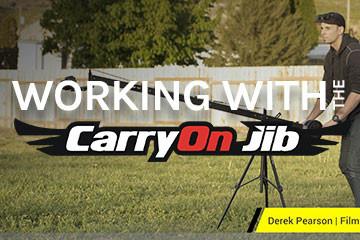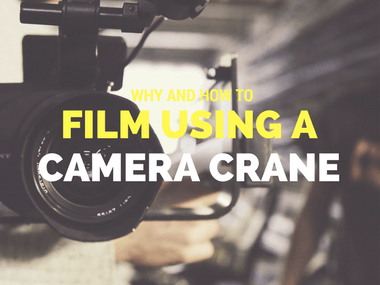Guest Post by Craig Kotilinek
A mini jib, classified in this article as anything less than eight feet, is an inexpensive and smooth way to take your production to the next level. Everyone seems to be jumping on the Movi craze and before that it was sliders. These are great tools but when everyone uses them everyone’s productions start to look the same. This is where a mini jib can come in very handy in setting your final product apart (and above) the competition, but there are some things you’re going to want to be aware of before setting out on your first mini jib shooting adventure.
1. Get some casters
Invest in some decent casters. You’ll thank me later. They’re a life saver when it comes to mobility and as long as you get a good set, you can even do some dolly moves as long as the surface you’re rolling on is nice and smooth (warp stabilizer in Premiere should take out any bit of remaining wiggle). They also mean you don’t have to heave a 50-pound rig up on your shoulder every time the client wants to “maybe move over a foot.” Life saver. And when I say invest, it’s not exactly a mortgage payment, we’re talking under $100. Casters also allow you to lock them when you don’t want the rig to move, which will be often.2. Wide angle
Get a good wide angle to throw on your rig for the most latitude in commercial filmmaking. Most of us aren’t out on set with an army of grips doing our bidding and with shot lists getting longer while budgets get shorter, a mini jib with a wide angle gets the job done quicker and with more visual appeal than anything I’ve seen. I personally adore the Tokina 11-16 f2.8 for its sharpness, depth of field and lack of distortion. I know, 11-16 is almost prime, but it’s just enough zoom to be useful while still having a constant F-stop, which is critical when you’re a single-man jib crew. I might switch over to a 24-70 now and then but I’m pretty much living on the 11-16 and loving the results. Also, you can really leverage a mini jib’s strengths with a wide-angle’s natural field of view, which brings us to point three.3. Foreground objects
Use the wide-angle’s field of view to get a foreground object involved that reveals the subject or creates parallax and a smooth sense of motion. Get close. Probably closer than you think. Not close enough to see your camera’s reflection, but a close-up jib shot sweeping by an object looks amazing. If you’re too far it just looks like a lack of intent and composition.4. Pick your shots
Used properly, a mini jib can create an incredible sense of smooth movement and parallax. Used with less skill, it’s a cheesy toy that might as well have been a fluid-head tripod (not that the latter is cheesy, it just doesn’t have as much potential as a mini jib with a talented operator). For example, if you just pull your mini jib out and swing it from side to side at a distance from the subject and at waist height, it might as well be a tripod. Good, but not great. Instead try sweeping the ground with the same motion. Totally different result that you can’t easily get from a fluid head tripod. Next, go up to the mini jib’s max height and do the same thing. Again, you’re getting a unique shot that would be hard to do with any other type of gear.5. Less is more
Like most video moves, try to keep things simple. Going up from the ground or down from the ceiling is a great place to start. Side to side is nice as well, but mind the rule above. Start out slow before you create your dollying jib shot with a rack focus. Crawl first.6. A monitor is nice, but not crucial
I shoot with a Canon 70D on my mini jib and it works perfectly because it’s compact, light and has an articulating screen. If you have an articulating screen you really don’t need an external monitor. Is it nice to have? Absolutely, particularly if a client really wants to review each move. But the point is the extra investment in a monitor shouldn’t stop you from buying a mini jib because you can absolutely get by without it. Just keep your depth of field somewhat deep, set your focus ahead of time and roll with it.7. Size matters
And mobility matters. My mini jib is eight feet and with the full rig mounted on casters it can still make it fairly easily through standard doorways and into elevators. The latter is crucial because you can make your life really easy by shooting a lot of commercial b roll with a mini jib rolling around an office or plant or whatever, but you can make your life a lot more difficult if you have to constantly carry the thing around or disassemble it.If you want to see some examples of a master mini jib operator (and humble too) check out my demo reel at floridavideographer.com and if you have any questions please don’t hesitate to contact me.
Craig Kotilinek
CSK Creative
FloridaVideographer.com
407.718.1112



